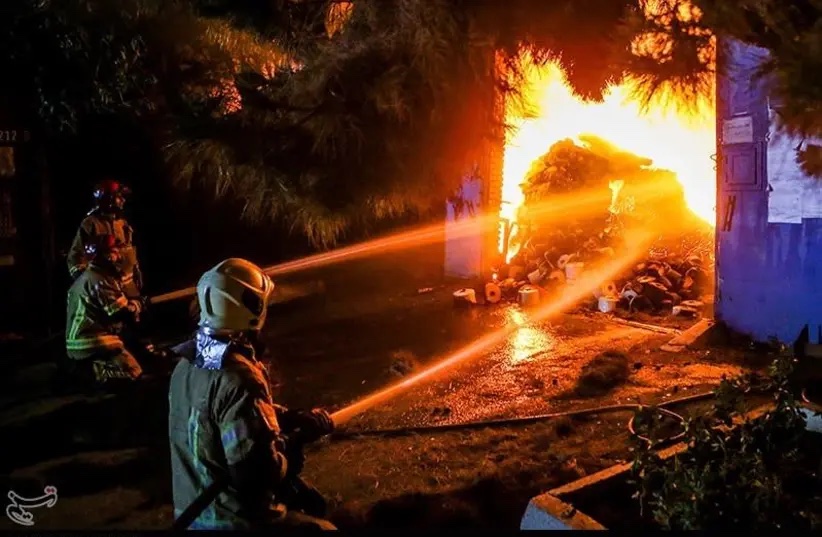by Hugh Fitzgerald

No one has claimed credit for the two recent cyberattacks on Iran’s Transport Ministry. But we can hazard a guess as to who was most likely behind them.
Here’s what those unidentified, bur identifiable, saboteurs were up to on July 9:
Train services in Iran were delayed by apparent cyberattacks on Friday, July 9, with hackers posting the phone number of the country’s Supreme Leader as the number to call for information, state-affiliated news outlets reported.
Trains were delayed or canceled as ticket offices, the national railway’s website and cargo services were disrupted, with “unprecedented chaos at railway stations across the country,” the state broadcaster IRIB reported.
A notice on electronic boards at stations asked travelers to call a number which in fact belonged to the office of Supreme Leader Ayatollah Ali Khamenei, IRIB and the semi-official news agency Fars said.
“Long delays due to cyberattacks,” said another notice on station boards, Fars added.
IRIB later quoted a state railway company spokesman as saying technicians were checking the disruptions and denying that there were major delays.
That was on Friday. The next day, July 10, there was a large explosion at a park in Tehran, apparently caused by a stun gun. It is reported on here:
A large explosion was heard in Iran’s capital on Saturday, according to the Iranian Fars News agency.
Later reports indicated that the explosion was caused by a stun grenade – a device which explodes with bright light and a loud sound – which had been set up to go off in a park near an adjoining hospital building, a TV reporter said.
More important, the explosion was set off near the headquarters of the state radio and television.
Tehran Deputy Governor Hamid Reza Goudarzi, who is in charge of security issues in the city, visited the site.
“Just one explosion took place inside Mellat (People) Park,” he told the semi-official Tasnim news agency.
Asked whether the incident was an attack, Goudarzi said: “We are investigating the dimensions and causes of the incident and we will provide information after we are sure.”
Deputy Security Chief for Tehran Province Hamidreza Goudarzi has been quoted by the IRGC-affiliated Tasnim News as saying that the incident is under investigation, it was unclear at this time what caused it, and it is unknown whether or not it was an act of terrorism.
This explosion in the Tehran park was mainly an attempt to disturb the equanimity of the authorities. In a hundred sundry ways – with major attacks on nuclear facilities, petrochemical plants, power plants, missile sites, nuclear scientists, cyberwarfare with the Stuxnet computer virus, and sabotage at Natanz that destroyed thousands of centrifuges – the Islamic Republic’s nuclear project has been under severe assault. But other attacks, less deadly – including the cyberwarfare that caused “unprecedented chaos” in the railroads, or this stun gun explosion the next day — serve as less-deadly reminders that the Islamic Republic’s enemies neither slumber nor sleep, and can strike where they will.
And on Saturday, there was a second cyberattack on the website of the Transport Ministry, discussed here:
The website of Iran’s transport ministry was taken down on Saturday by what state television said was a “cyber disruption,” a day after an apparent cyberattack on the state railway company.
Computer systems of the staff of the Ministry of Roads and Urban Development were the subject of the attack which resulted in the ministry’s portal and sub-portal sites becoming unavailable, the TV channel reported.
It didn’t give any indication of who it believed could have been behind the attack and did not say if any ransom demand had been made.
Telecommunications Minister Mohammad Javad Azari-Jahromi warned on Saturday of possible ransomware attacks unless vulnerabilities in computer systems were dealt with, Iranian news outlets reported.
Iran says it is on high alert for online assaults, which it has blamed in the past on the United States and Israel.
We’ll see just how “high” that high alert turns out to be during the next few months, as the world witnesses more of those cyberattacks that will keep on rattling the Islamic Republic.
No one has claimed credit for any of these attacks. But they don’t need to. You know, and I know – and the Iranians know, too – who is almost certainly behind them. The same country that brought us Stuxnet, and sabotage at centrifuge plants, both aboveground and 50 meters underground, at Natanz, and whose agents managed to steal Iran’s nuclear archive, and engage in other acts of derring-do, including the targeted assassinations of five nuclear scientists. The same people who have been responsible since 2020 for “mysterious explosions” at petrochemical plants, power plants, and alleged missile sites around Iran. The Iranian dissidents in exile have written a letter to Prime Minister Naftali Bennett, asking that little Israel keep up the good work in Iran. And of course, to the Islamic Republic’s great discomfiture and chagrin, little Israel will do exactly that.
First published in Jihad Watch.
- Like
- Digg
- Del
- Tumblr
- VKontakte
- Buffer
- Love This
- Odnoklassniki
- Meneame
- Blogger
- Amazon
- Yahoo Mail
- Gmail
- AOL
- Newsvine
- HackerNews
- Evernote
- MySpace
- Mail.ru
- Viadeo
- Line
- Comments
- Yummly
- SMS
- Viber
- Telegram
- Subscribe
- Skype
- Facebook Messenger
- Kakao
- LiveJournal
- Yammer
- Edgar
- Fintel
- Mix
- Instapaper
- Copy Link









